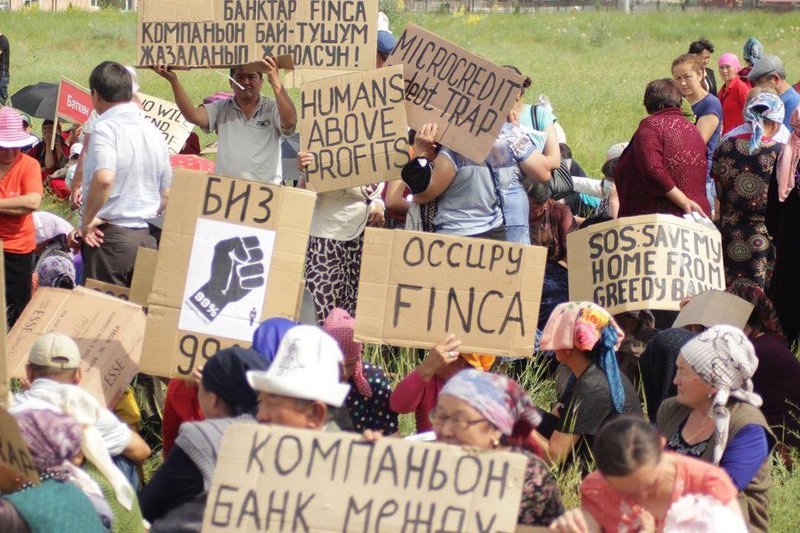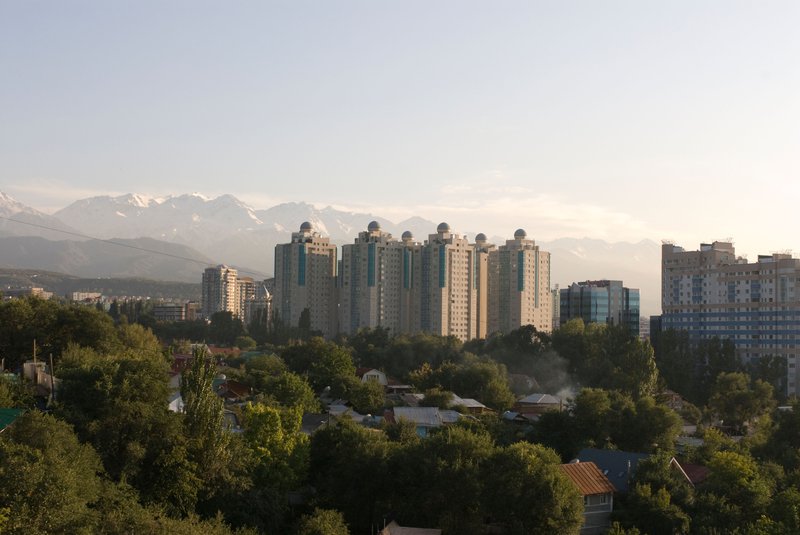Credit trap: debt and dispossession in Central Asia
Since the collapse of the USSR, credit has slowly taken hold as the only way to make ends meet in Kazakhstan and Kyrgyzstan. All too often it ends in tragedy
 |
On 15 April this year, 15 women seized a local state administration building in northern Kyrgyzstan. Their demands: debt relief and the prevention of their houses being repossessed.
Barricading themselves inside the building, the women – clad in black headscarves as a sign of mourning – threatened to pour petrol over their bodies and set themselves alight if the country’s prime minister refused to negotiate with them. They placed gas cylinders along the office windows and poured petrol on the floor, setting the scene for a large explosion.
“We’re sick of financial slavery! Eradicate usury!” the women announced as they struggled to breathe in the room full of fumes. These women had spent years battling financial oppression, and had finally reached the end of their tether.
In 2019, Kyrgyzstan had the fifth-highest real lending interest rate in the world. For more than a decade, women in the country’s rural areas have been protesting against debt, house repossessions and exorbitant interest rates. Many, though not all, have pointed the finger at external actors, such as a 2016 protest against the United States Agency for International Development (USAID) and the World Bank’s International Finance Corporation (IFC), for creating and funding exploitative microcredit companies in Kyrgyzstan.
Kyrgyzstan is not alone. Debt has also crept into all corners of life in neighbouring Kazakhstan, where activists have also tried to campaign against its destructive effects. In 2014, people from five major cities rallied in front of the country’s Central Bank to demand a debt amnesty. Over the years, the activists have blamed the state for sanctioning predatory lending arising from western credit flows.
Indebting the poor, especially vulnerable women, has become a legalised form of robbery for the financial industry in Central Asia
Job losses due to the Covid-19 pandemic have exacerbated the debt burden in these two countries. Thousands of migrants who normally work in Russia have returned home to Kyrgyzstan, causing an unprecedented decrease in remittances – a vital lifeline for families when it comes to basic necessities. As the state could not offer any income support to its workforce, of which 75% is self-employed, the pandemic pushed an additional 700,000 people into poverty in Kyrgyzstan, worsening an already critical situation where 50.3% of the population suffers from various forms of deprivation. In oil-rich Kazakhstan, as 42% of the population lost income and applied for income support of 42,500 tenge ($99), the government made a one-off payment in full in May 2020 and a partial payment the following month.
In order to provide some relief, central banks in the region recommended that loan repayments be deferred for up to three months. However, commercial banks and microfinance institutions continued to charge interest on outstanding loans, as well as commission fees to change loan terms. Despite rising default rates, they refused to write off debt or suspend the accrual of interest, deepening indebtedness.
Indebting the poor, especially vulnerable women, has become a legalised form of robbery for the financial industry in Central Asia. Debt bondage, which causes immense harm for the poor and profits the rich, is neither natural nor inevitable.
New credit relations
In order to understand the root of the problem, one must start from the beginning.
When Central Asian states gained independence in 1991, much of the population did not have personal or commercial debt. The Soviet economic system prohibited lending at interest “non-labour” (or unearned) income was both condemned and strictly regulated.
But after the disintegration of the Soviet Union, the Central Asian republics compensated for their severe shortage of capital by borrowing from US and other western financial institutions at high interest rates. This near-monopoly on credit coerced Central Asian citizens, especially low-income groups, into entering into exploitative high-risk credit relations.
Starting in the mid-1990s, international donors and investors developed the microcredit industry in Kyrgyzstan by funding four microfinance institutions: Bai Tushum, FINCA, Kompanion and Mol Bulak. The IFC and other donors mandated these lenders to become fully commercialised in order for them to achieve high returns on equity, with a colossal 44% average interest rate on loans.
Women constitute a large share of debtors in Central Asia. Like many parts of the Global South, international donors and investors targeted vulnerable women for microcredit lending
By 2010, these four organisations served 77% of microcredit borrowers in Kyrgyzstan, controlling 52% of the country’s microcredit portfolio. By 2016, three of them had become fully-fledged banks, while continuing to hold a significant portfolio in microlending.
In Kazakhstan, the oil boom in the early 2000s fuelled a rapid expansion of credit in the banking sector. By 2007, Kazakhstani banks had amassed $46 billion in external debt, equivalent to 44% of the country’s gross domestic product (GDP). Since about 70% of those loans were linked to the real estate sector, house prices skyrocketed. Today, housing costs in Nur-Sultan and Almaty surpass those in exclusive cities such as San Francisco and Vancouver. Today, over 80% of Kazakhstanis are in debt with mortgage and consumer loans.
In both countries, the governments deregulated the financial system, allowing banks and microfinance institutions to determine loan size, interest rates, commission fees and penalties, while operating with minimum capital and licensing requirements, with some lenders charging interest rates as high as 180% as a result. According to several sources spoken to by the author, penalties sometimes doubled the principal loan, and some lenders had up to 25 different commission fees.

Finally, neoliberal financial deregulation in Kazakhstan and Kyrgyzstan minimised legal protections for borrowers. The financial industry blocked individual bankruptcy laws so that collateral could be seized and sold. In the absence of such laws, the courts sided with lenders and justified repossessions on the basis of the rule of law and the sanctity of the contract.
Indebting women
Women constitute a large share of debtors in Central Asia. Like many parts of the Global South, international donors and investors targeted vulnerable women for microcredit lending.
This reflected a global neoliberal strategy for debt-based growth, which recast marginalised groups as an investment opportunity. High interest loans were sold as an effective way to combat poverty, empower women, and stimulate entrepreneurial activity. Yet when the author pressed an IFC manager to explain the obvious tension between this social framing and for-profit lending, they defensively retorted: “We are not a charity but an investment bank! So of course, we need to make a profit.” Perversely, by indebting poor women, international investors gained both a handsome profit and a public image as do-gooders.
In Central Asia, debt – rather than social rights – has enabled people to access basic goods. The responsibility for citizens’ well-being has shifted from the welfare state to individuals through private lenders
For many women, loans were not a matter of choice, but a necessity as a result of cuts to state expenditure on social and economic programmes. The cumulative impact of market reforms in the region facilitated poor women’s dependence on high interest credit.
First, the privatisation of state enterprises significantly reduced pay and job opportunities for women. If in 1988 the Soviet Union had the highest female labour force participation rate of any industrialised society, with 90% of working-age women engaged in either full-time work or study, by 2017 the female participation rate in Kyrgyzstan had fallen to 48%. For instance, by 1995 fewer than 10,000 people worked in the country’s light industry sector, which used to employ over 100,000 mostly female workers in Soviet times.
Moreover, the privatisation of land and agriculture made women asset-poor. While most assets – including 80% of land and 61% of real estate – were transferred to a small minority of owners, mostly men, many women previously employed as factory or agricultural workers, as well as teachers or healthcare specialists, were forced into petty trade through western-sponsored microcredit schemes. The commodification of labour and poor income fuelled the expansion of debt.
Second, many women borrowed money to pay for services, such as health care and education, which saw significant cuts in state spending as well as mass privatisation, enabling affluent groups to access better quality services, while low-income groups have been deprived of them. In Kyrgyzstan, the commodified provision of reproductive health care led to the highest maternal mortality rate in the post-Soviet space, with 90% of deaths found to be preventable. In Kazakhstan, a 2021 survey of online microcredit borrowers showed that 29% of respondents took out loans to pay for emergency expenses, 21% to make ends meet, and 16% to pay off debt on bank loans; the remaining 34% used such loans to pay for medical treatment, utilities, and educational fees.
Third, the state’s withdrawal from the provision of free housing and the adoption of mortgage-based schemes resulted in fewer new affordable housing units and real estate price inflation, a combination that has driven economic disparity. Today, out of 8.4 million economically active people in Kazakhstan, over six million cannot afford to buy a house. Many households have taken out US dollar-denominated mortgage loans at interest rates of 15-20% in order to be able to buy a house.

In Central Asia, debt – rather than social rights – has enabled people to access basic goods. The responsibility for citizens’ well-being has shifted from the welfare state to individuals through private lenders. As a result, debt has become foundational, a way of life. Women in particular have been forced into debt to cope with the increasing costs of a commodified society and as a way of staying afloat or getting ahead in life.
Almost three decades of debt expansion has produced immense misery and violence in the lives of ordinary people in the region. After the 2008 financial crisis, over 70,000 Kazakhstanis defaulted on their mortgage loans, while 62,889 new apartment owners were left stranded with their housing complexes partly built.
In Kyrgyzstan, about 30% of all borrowers are over-indebted, meaning that individuals struggle to repay loans on time, forcing them to take out multiple loans and make unacceptable sacrifices to meet payments. The director of one of the country’s microfinance associations admitted that the majority of borrowers paid back “at the cost of sacrificing their food security, education and health, which obviously caused them immense misery”.
Faced with an increase in non-payments, the financial sector pursued an aggressive strategy of foreclosures by undertaking seizure of borrowers’ properties. Until recently, a delay in payment of over 60 days allowed lenders to seize the collateral without a court order, as, unlike in other countries, microfinance institutions in Central Asia secured their small loans with collaterals. As a result, many borrowers in Kyrgyzstan lost their homes over microcredit loans of around US$1,000.
The rise in evictions caused many borrowers to commit suicide, due to the overwhelming shame and loss of control. In Kyrgyzstan, 17 women who were facing repossessions took their own lives in 2011-12. In Kazakhstan, it has become common to read news headlines of debt-related tragedies. For example, in 2011, Marat Nurkenov, a 39-year-old resident of Pavlodar, took his own life after law enforcement agents evicted his parents from their apartment.
The same year, Kenzhegul Alinkulova, a mother of five, set herself alight during a forced eviction in Almaty. (She survived.) After 27 soldiers took their own lives during 2014, the country’s Ministry of Defence started a registry of heavily-indebted military personnel as a suicide prevention strategy in the army – an official acknowledgement that debt-related suicides had become a major problem.
The death of a borrower, however, does not extinguish the debt. Existing banking and microfinance laws make family members responsible for loans that are secured against property registered under their names
The death of a borrower, however, does not extinguish the debt. Existing banking and microfinance laws make family members responsible for loans that are secured against property registered under their names. In such cases, banks and microfinance institutions collect the outstanding balance from surviving family members. In Kyrgyzstan, a borrower recounted how collectors would show up at funerals, pulling aside crying family members to tell them to “make sure to give us the money that people have brought for the funeral”, as it is a custom for visitors to donate money to the bereaved family in order to help to pay for expenses.
While collectors’ lack of sympathy for grieving family members and their blatant disrespect for social customs infuriated many, local activists found it difficult to hold banks and microfinance institutions accountable for driving borrowers to their death, even when death notes were left behind.
Debt, violence and fraud
The daily lives of those in debt are filled with feelings of shame, fear, and anxiety. Public shaming and other aggressive collection methods are employed to maximise the rate of debt repayment.
In Central Asia, it is common for debt collectors to publicly humiliate borrowers and threaten them with legal action or bodily harm. Speaking to the author, a schoolteacher in Kyrgyzstan described how collectors came to her school and shamed her in front of her students and the school director. This level of humiliation and intimidation was a novel experience for many borrowers, who recount shaking, having heart palpitations or panic attacks every time someone knocks on their doors or the phone rings.
The financial industry often exploited cultural norms to shame and dishonour women, too. In Kyrgyzstan, some lenders and debt collectors used regional governors and the courts of male elders to chasten women for missing loan repayments. In some cases, the damage to women’s reputations led to their being condemned by family members and being socially marginalised. The mechanism of shaming has proved to be very effective, explaining the paradox of high repayment rates by vulnerable women.
Moreover, microfinance lenders promoted group-based loans on female borrowers in order to intensify social scrutiny in comparison to individual market transactions between lenders and borrowers, as members of a woman’s family or social network are turned into quasi-debt collectors, personalising debt and discipline and heightening the feeling of shame. Whenever someone defaulted, group loans produced tensions and conflicts within close-knit communities. In one case, a group of women borrowers revealed how they were greatly distressed by “the pain they inflicted on each other”, when one had to use her meagre pension to meet the group’s liability.
The power imbalance between lenders and borrowers is huge, and indebted women alone cannot take on the global power of financial institutions
Since 2006, illegal private debt collection agencies have grown in Kazakhstan, where next to only 193 officially registered agencies, at least a thousand operate illegally. In 2019, the country’s banks sold problematic loans worth 611.6 billion tenge ($1.4 billion) to collection agencies. Kazakhstani social media posted video and voice recordings exposing these agencies’ abuses, including physical assault.
A 2019 video shows a young male collector from the unregistered Almaty Collection Group threatening a young female debtor, calling her “dirt-eating trash” and “a mistake” who shouldn’t have been born. When the young woman filed a legal complaint, he and two accomplices attacked a senior partner at the law firm who helped her, breaking his nose and ribs. In the same year, Kazakhstani courts reviewed 353 complaints against debt collectors. The maximum punishment for debt collectors who violate the law is a mere 180 hours of correctional labour. As a result, private collectors continue acting with impunity, using threats and physical force to extract debt.
Recently, private debt collection firms have been able to open private law enforcement agencies to increase their coercive powers. Debt collectors can now access state and commercial databases on debtors, and can use extensive legal powers, such as the seizure of property, sale at auction, access to bank accounts, and the imposition of travel restrictions.
Access to records on debtors is responsible for the development of sophisticated fraudulent tactics to ‘recover’ debt. For instance, in a recent case, a debtor and mother of five was on a waiting list for state-subsidised housing. One day, she received a telephone call informing that her application had been approved, but the paperwork was on hold because of her outstanding loan. She was urged to borrow money to pay off the bank loan in order to complete the process. After paying off the debt, she learnt that she had been scammed by the debt collectors.
Economic inequality in Central Asia is among the highest in the world. Debt has transferred income from the poor to the rich, in what Michael Hudson aptly calls a regressive form of income distribution. Between 1995 and 2012, microcredit was responsible for transferring up to $125 billion from poor communities in the Global South to financial centres in the Global North, a regressive distribution of global wealth partly achieved at the expense of poor rural women.
In Central Asia, women have tried to resist debt bondage, but their resistance has not achieved meaningful changes to predatory lending practices in the region, as governments have suppressed protests, while indebted women have often been demonised and stigmatised by the media as unscrupulous and irresponsible borrowers lacking discipline and financial literacy.
The power imbalance between lenders and borrowers is huge, and indebted women alone cannot take on the global power of financial institutions. People’s passivity over the regulation of finance reflects the degree to which the neoliberal moral order has come to be accepted as just and natural. The task of global anti-debt movements such as the Tax Justice Network and the Jubilee Debt Campaign, therefore, is to challenge the power of finance, and call for progressive alternatives.
This global coalition must overcome the economic and moral stranglehold of finance over society, so that finance serves the well-being of the people rather than the economic interests of the lenders.


No comments:
Post a Comment
Note: only a member of this blog may post a comment.